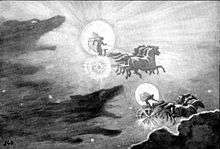Svartálfar
In Norse cosmology, svartálfar (O.N. "black elves", "swarthy elves", sing. svartálfr), also called myrkálfar ("dark elves", "dusky elves", "murky elves", sing. myrkálfr),[1][2] are beings who dwell in Svartalfheim (Svartálf[a]heimr, "home of the black-elves").[3] Both the svartálfar and Svartálfaheimr are primarily attested in the Prose Edda, written in the 13th century by Snorri Sturluson. Scholars have noted that the svartálfar appear to be synonymous with the dwarfs and potentially also the dökkálfar ("dark elves"). As dwarfs, the home of the svartálfar could possibly be another description for Niðavellir ("dark fields").
Attestations
The svartálfar are almost only attested in the Prose Edda (the word does appear in Ektors saga ok kappa hans, but is presumably borrowed from the Prose Edda).[4] The svartálfar mentioned in Skáldskaparmál 35 are the Sons of Ivaldi, whom Loki engages to craft replacement hair for Sif, wife of the god Thor, after Loki mischievously sheared off her golden tresses.[5] Ivaldi is often glossed as being a dwarf.[6]
Svartálfaheimr ("world of black-elves") appears in the Prose Edda twice,[3][7] in each case as the place where certain dwarfs can be found to be living:[8] In Gylfaginning 33, the "world of black-elves" is where the dwarfs are sought by the gods to craft the fetter Gleipnir to bind the wolf Fenrir.[9] And in Skáldskaparmál, 39, the "world of black-elves" is where Loki encounters the dwarf Andvari.[10]
Theories and interpretations
Scholars have commented that, as both attestations mentioning the beings and location appear to refer to dwarfs, svartálfr and dwarf may simply be synonyms for the same concept.[11] Scholar John Lindow comments that whether the dökkálfar and the svartálfar were considered the same at the time of the writing of the Prose Edda is also unclear.[12]
See also
Notes
- Michaud, Joseph Fr. Michaud, Louis Gabriel. "Biographie universelle, ancienne et moderne; ou, Histoire, par ordre alphabétique" vol. 53. pg. 143. 1832
- Crawford, Alexander. "The Creed of Japhet". pg. 19. W. Clowes and Sons, Limited, 1891.
- Faulkes 1995, pp. 28, 100
- Alaric Hall, Elves in Anglo-Saxon England: Matters of Belief, Health, Gender and Identity, Anglo-Saxon Studies, 8 (Woodbridge: Boydell, 2007), p. 24.
- Faulkes 1995, p. 96
- Larrington 1996, p. 312, trans., Poetic Edda, annotated index: "Ivaldi; a dwarf. Grimnismál 43.1"
- Finnur Jónsson 1911 ed. Edda, index under Svartálfaheimr (p.365) which cross-references to pp. 51, 175.
- Tolkien, J. R. R. (2012). The Legend of Sigurd and Gudrun. Houghton Mifflin Harcourt.
- Faulkes 1995, p. 28
- Faulkes 1995, p. 100
- Lindow (2001:110), Orchard (1997:20), and Simek (2007:305).
- Lindow (2001:110).
References
- Faulkes, Anthony (trans.) (1995). Edda: Snorri Sturluson. Everyman. ISBN 0-460-87616-3.
- Lindow, John (2001). Norse Mythology: A Guide to the Gods, Heroes, Rituals, and Beliefs. Oxford University Press. ISBN 0-19-515382-0.
- Orchard, Andy (1997). Dictionary of Norse Myth and Legend. Cassell. ISBN 0-304-34520-2.
- Simek, Rudolf (1984). Lexikon der germanischen Mythologie. Stuttgart: A. Kröner. ISBN 3520368013.
- Simek, Rudolf (2007). Dictionary of Northern Mythology. Angela Hall (trans.). D.S. Brewer. ISBN 0-85991-513-1.
